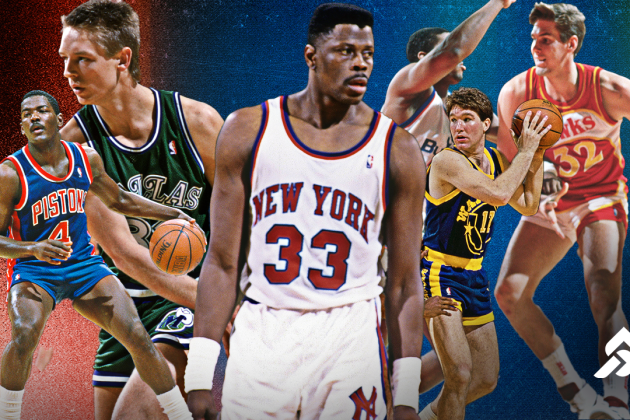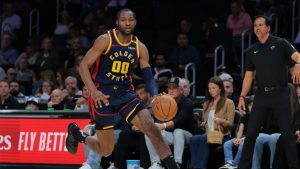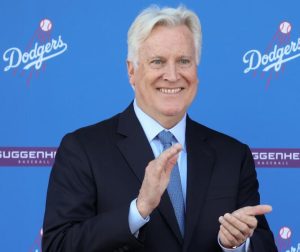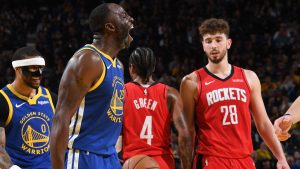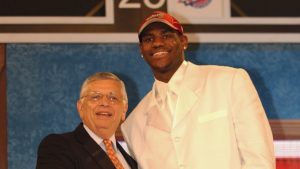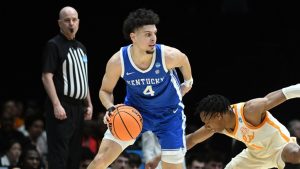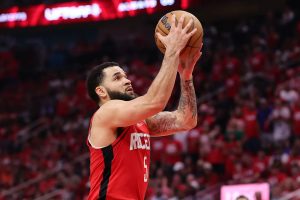In 1985, the NBA introduced a lottery system to decide the draft order of non-playoff teams—a revolutionary development with a legacy that still lingers on the lottery’s 40th anniversary.
Before 1985, the team picking first overall had been determined through a coin flip between the worst teams in each conference. Under the new drawing method, envelopes containing names of all the teams that missed the postseason the prior campaign were mixed up in a sphere before then-commissioner David Stern reached in, grabbed one and revealed it to the world.
The New York Knicks were the first lottery winners, benefiting from a reach-and-grab that has been the subject of countless YouTube deep dives over the years. People have long speculated that the lottery was rigged for the big-market Knicks despite attempts from the NBA to shut down the rumors. Was New York’s envelope frozen, or its corner bent to help Stern identify it? Probably not, but the massive exhale taken by the former commish before doing his duty added fuel to the decades-old theories.
Conspiracies have remained a hallmark of the lottery ever since. That includes the evidence-deficient chatter this year after the Dallas Mavericks won the 2025 No. 1 pick—and the chance to take Duke phenom Cooper Flagg on Wednesday night—despite finishing with a record near .500. (The Utah Jazz—who held the worst record of the 2024-25 season at 17-65, a .207 winning percentage—will be picking fifth overall.)
The lottery has evolved over the years. Envelopes became ping-pong balls, and the NBA tilted the odds heavily in favor of the worst teams in 1993 before returning to more flattened odds in 2019 to disincentivize tanking, which contributed to Dallas winning the Flagg sweepstakes.
While the clearest through-line from the 1985 draft to 2025 draft is the lottery, the event 40 years ago has a lot more intrigue to offer.
For starters, the 1985 draft may well be the best of all time. The class as a whole produced 1,707 career win shares, a Basketball-Reference statistic which attempts to divvy up individual credit for team success. That’s about 10% more than the next-highest class, which amazingly was 1984, featuring some guy named Michael Jordan. (When fans revel in the nostalgia of the late ’80s and early ’90s, they actually have a point!)
The 1985 draft produced 10 All-Stars, tied for the most of any draft since the ABA/NBA merger in 1976. Four of those players became Hall of Famers—Patrick Ewing, Chris Mullin, Karl Malone and Joe Dumars. Technically, Lithuanian Hall of Fame center Arvydas Sabonis was selected with the No. 77 pick, but the selection was voided because Sabonis was not yet 21 at the time of the draft.
Even with Sabonis excluded, the 1985 draft was a banner year for international prospects, with Detlef Schrempf, Uwe Blab and Bill Wennington among the first-rounders selected. And that list doesn’t include No. 1 overall pick Ewing, who was born in Jamaica but moved to the U.S. at 13. A whopping eight foreign-born players were picked in the first 50 slots, a number that wouldn’t be topped for more than a decade. Last year, 17 of the first 50 picks were born outside the U.S.
Schrempf was the first European to ever be drafted in the top 10, and his successful career, which included an All-NBA nod in 1994-95 and an NBA Finals appearance in 1996, inspired teams to take more chances on overseas talent.
Canadian big man Wennington was drafted fresh off a Final Four appearance with St. John’s, one of three Big East teams to make the March Madness semifinals in 1985. That calendar year perhaps marked the absolute peak of the conference, as four Big East players were drafted in the top 10 for the first and only time ever.
In addition to the international talent wave, 1985 draftees foreshadowed other modern NBA trends. No. 5 overall pick John Koncak averaged just 4.7 points per game in 1988-89, but he nonetheless received a six-year, $13 million deal from the Atlanta Hawks that summer. Suddenly, big money wasn’t just for superstars. Or stars. Or starters. Known ever since as “Jon Contract,” the career backup was remarkably candid, and prescient, in an interview with Sports Illustrated at the time. “Hey, I can’t justify what they offered me,” Koncak said. “But what was I supposed to do? Say no? The league is changing. I think maybe this is just the start.”
Sporticowrote earlier this season about the latest phase of the league’s 3-point revolution—ball-dominant guards pulling up more often from beyond the arc. But Michael Adams was doing that before it was cool. The 5-foot-10, No. 66 overall pick in 1985 thrived under Denver Nuggets coach Doug Moe’s breakneck pace and led the NBA in 3-point attempts for four straight seasons, a feat nobody else achieved until Steph Curry.
A horde of other characters drafted 40 years ago deserve entire books written about them, but they will have to settle for just a sentence devoted to them here. No. 2 pick Wayman Tisdale averaged 22.3 points per game in 1990 for the Sacramento Kings and then went on to record eight music albums primarily as a bassist, including one that climbed to No. 1 on Billboard’s contemporary jazz chart, before his death in 2009. Sudan’s 7-foot-6 Manute Bol became the only player to ever retire with more blocked shots than points scored before becoming a political activist and humanitarian; Bol died in 2010.
There’s AC Green, best known for his iron man streak during which he played an NBA record 1,192 consecutive games—and only slightly less known for his claims of being a virgin throughout his career, until his marriage in 2002. Don’t sleep on Terry Porter, who made only two All-Star games with the Portland Trail Blazers, but whose stats portray a playoff-riser, efficient shooter and low-turnover distributor who ranks 73rd all-time in win shares. Seventh-rounder and No. 160 overall pick Mario Elie played overseas for five years before finally getting a chance in the NBA, where he won three titles and made one of the most clutch shots in league history—a game-winning trey in Game 7 of the 1995 Western Conference semifinals.
There was lots of talent to be mined in the later rounds of the 1985 draft. Spaniard Fernando Martin, selected at No. 38, played just one NBA season but was the second-leading scorer for his 1984 Olympic silver medal-winning team. Another member of the single-season club, No. 41 pick Lorenzo Charles, will forever be known for his buzzer-beating put-back dunk in the championship game of the 1983 NCAA tournament to lift Cinderella North Carolina State to victory over heavily favored Houston.
John “Hot Rod” Williams averaged double-digit points for nine consecutive seasons and boasted one of the league’s best nicknames—not bad for the No. 45 pick. Gerald Wilkins, chosen last in the second round, brought out the first prop in dunk contest history in 1986 when he jumped over a folding chair (“Isn’t that incredible!?” the announcer exclaimed with more enthusiasm than Spike Lee watching Mac McClung jump over a car 39 years later).
Speaking of dunk contests, the No. 87 overall pick, 5-foot-7 Spud Webb, won that 1986 event and carved out a role in the NBA over a 12-year career despite his stature. Today, players under 6 feet are nowhere to be seen (although the Grizzlies’ 5-foot-8 Yuki Kawamura is trying his darndest).
Remarkably, 1985 isn’t the only superlative draft class celebrating a significant anniversary this year. The worst cohort of all-time by that simple win shares metric is 2000. Maybe Kenyon Martin and Stromile Swift can get together and crack open a bottle of champagne.
Sign up for Sportico’s Newsletter. For the latest news, follow us on Facebook, Twitter, and Instagram.
In 1985, the NBA introduced a lottery system to decide the draft order of non-playoff teams—a revolutionary development with a legacy that still lingers on the lottery’s 40th anniversary.
Before 1985, the team picking first overall had been determined through a coin flip between the worst teams in each conference. Under the new drawing method, envelopes containing names of all the teams that missed the postseason the prior campaign were mixed up in a sphere before then-commissioner David Stern reached in, grabbed one and revealed it to the world.
The New York Knicks were the first lottery winners, benefiting from a reach-and-grab that has been the subject of countless YouTube deep dives over the years. People have long speculated that the lottery was rigged for the big-market Knicks despite attempts from the NBA to shut down the rumors. Was New York’s envelope frozen, or its corner bent to help Stern identify it? Probably not, but the massive exhale taken by the former commish before doing his duty added fuel to the decades-old theories.
Conspiracies have remained a hallmark of the lottery ever since. That includes the evidence-deficient chatter this year after the Dallas Mavericks won the 2025 No. 1 pick—and the chance to take Duke phenom Cooper Flagg on Wednesday night—despite finishing with a record near .500. (The Utah Jazz—who held the worst record of the 2024-25 season at 17-65, a .207 winning percentage—will be picking fifth overall.)
The lottery has evolved over the years. Envelopes became ping-pong balls, and the NBA tilted the odds heavily in favor of the worst teams in 1993 before returning to more flattened odds in 2019 to disincentivize tanking, which contributed to Dallas winning the Flagg sweepstakes.
While the clearest through line from the 1985 draft to 2025 draft is the lottery, the event 40 years ago has a lot more intrigue to offer.
For starters, the 1985 draft may well be the best of all time. The class as a whole produced 1,707 career win shares, a Basketball-Reference statistic which attempts to divvy up individual credit for team success. That’s about 10% more than the next-highest class, which amazingly was 1984, featuring some guy named Michael Jordan. (When fans revel in the nostalgia of the late ’80s and early ’90s, they actually have a point!)
The 1985 draft produced 10 All-Stars, tied for the most of any draft since the ABA/NBA merger in 1976. Four of those players became Hall of Famers—Patrick Ewing, Chris Mullin, Karl Malone and Joe Dumars. Technically, Lithuanian Hall of Fame center Arvydas Sabonis was selected with the No. 77 pick, but the selection was voided because Sabonis was not yet 21 at the time of the draft.
Even with Sabonis excluded, the 1985 draft was a banner year for international prospects, with Detlef Schrempf, Uwe Blab and Bill Wennington among the first-rounders selected. And that list doesn’t include No. 1 overall pick Ewing, who was born in Jamaica but moved to the U.S. at 13. A whopping eight foreign-born players were picked in the first 50 slots, a number that wouldn’t be topped for more than a decade. Last year, 17 of the first 50 picks were born outside the U.S.
Schrempf was the first European to ever be drafted in the top 10, and his successful career, which included an All-NBA nod in 1994-95 and an NBA Finals appearance in 1996, inspired teams to take more chances on overseas talent.
Canadian big man Wennington was drafted fresh off a Final Four appearance with St. John’s, one of three Big East teams to make the March Madness semifinals in 1985. That calendar year perhaps marked the absolute peak of the conference, as four Big East players were drafted in the top 10 for the first and only time ever.
In addition to the international talent wave, 1985 draftees foreshadowed other modern NBA trends. No. 5 overall pick John Koncak averaged just 4.7 points per game in 1988-89, but he nonetheless received a six-year, $13 million deal from the Atlanta Hawks that summer. Suddenly, big money wasn’t just for superstars. Or stars. Or starters. Known ever since as “Jon Contract,” the career backup was remarkably candid, and prescient, in an interview with Sports Illustrated at the time. “Hey, I can’t justify what they offered me,” Koncak said. “But what was I supposed to do? Say no? The league is changing. I think maybe this is just the start.”
Sportico wrote earlier this season about the latest phase of the league’s 3-point revolution—ball-dominant guards pulling up more often from beyond the arc. But Michael Adams was doing that before it was cool. The 5-foot-10, No. 66 overall pick in 1985 thrived under Denver Nuggets coach Doug Moe’s breakneck pace and led the NBA in 3-point attempts for four straight seasons, a feat nobody else achieved until Steph Curry.
A horde of other characters drafted 40 years ago deserve entire books written about them, but they will have to settle for just a sentence devoted to them here. No. 2 pick Wayman Tisdale averaged 22.3 points per game in 1990 for the Sacramento Kings and then went on to record eight music albums primarily as a bassist, including one that climbed to No. 1 on Billboard’s contemporary jazz chart, before his death in 2009. Sudan’s 7-foot-6 Manute Bol became the only player to ever retire with more blocked shots than points scored before becoming a political activist and humanitarian; Bol died in 2010.
There’s AC Green, best known for his iron man streak during which he played an NBA record 1,192 consecutive games—and only slightly less known for his claims of being a virgin throughout his career, until his marriage in 2002. Don’t sleep on Terry Porter, who made only two All-Star games with the Portland Trail Blazers, but whose stats portray a playoff-riser, efficient shooter and low-turnover distributor who ranks 73rd all-time in win shares. Seventh-rounder and No. 160 overall pick Mario Elie played overseas for five years before finally getting a chance in the NBA, where he won three titles and made one of the most clutch shots in league history—a game-winning trey in Game 7 of the 1995 Western Conference semifinals.
There was lots of talent to be mined in the later rounds of the 1985 draft. Spaniard Fernando Martin, selected at No. 38, played just one NBA season but was the second-leading scorer for his 1984 Olympic silver medal-winning team. Another member of the single-season club, No. 41 pick Lorenzo Charles, will forever be known for his buzzer-beating put-back dunk in the championship game of the 1983 NCAA tournament to lift Cinderella North Carolina State to victory over heavily favored Houston.
John “Hot Rod” Williams averaged double-digit points for nine consecutive seasons and boasted one of the league’s best nicknames—not bad for the No. 45 pick. Gerald Wilkins, chosen last in the second round, brought out the first prop in dunk contest history in 1986 when he jumped over a folding chair (“Isn’t that incredible!?” the announcer exclaimed with more enthusiasm than Spike Lee watching Mac McClung jump over a car 39 years later).
Speaking of dunk contests, the No. 87 overall pick, 5-foot-7 Spud Webb, won that 1986 event and carved out a role in the NBA over a 12-year career despite his stature. Today, players under 6 feet are nowhere to be seen (although the Grizzlies’ 5-foot-8 Yuki Kawamura is trying his darndest).
Remarkably, 1985 isn’t the only superlative draft class celebrating a significant anniversary this year. The worst cohort of all-time by that simple win shares metric is 2000. Maybe Kenyon Martin and Stromile Swift can get together and crack open a bottle of champagne.

